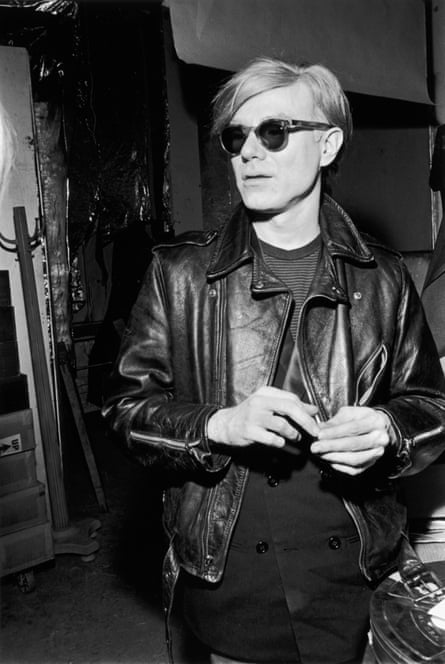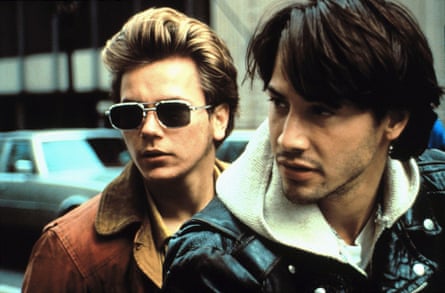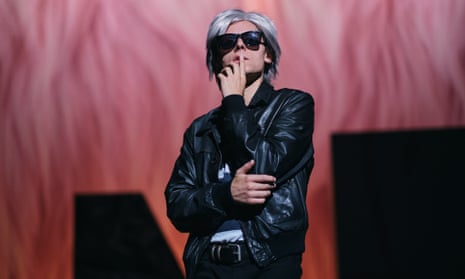In 1982, a 30-year-old Gus Van Sant was taking a stroll in New York on his lunch break when he spotted a legend. “I saw him walk by the street,” he remembers. “Madison Avenue, across from where I was working in advertising. He was wearing a light blue, lightweight parka and a backpack.” Engrossed in conversation, Warhol didn’t look in Van Sant’s direction but was immediately recognisable. “I was, like, ‘OK, there’s Warhol!’ He was very easy to spot.” The film-maker’s face creases into a warm smile, incredulous, as he chuckles. “He looked exactly as you see him in pictures.”
Four decades later, Van Sant is making his directorial stage debut in Lisbon with a musical play, Andy, all about the life of the high priest of pop art. It’s the latest unexpected turn from the Palme d’Or-winning director of Elephant, who was Oscar-nominated for Good Will Hunting and Milk, and whose more left-field cinematic experiments include a shot-for-shot remake of Alfred Hitchcock’s Psycho and a fictionalised account of Nirvana frontman Kurt Cobain’s final days.

When we meet in Lisbon, Van Sant reminisces about his younger years, visiting his aunt Joanne who would put on musicals such as Carousel at her college in Ohio. At that time, musicals and theatre did not pique his curiosity. “I grew up in the 50s and 60s when musicals were like the form within that era … now they’re kind of a new form.” The Book of Mormon and Hamilton, he says, changed the way he thought about musical theatre and the potential the form had. “I thought stuff was happening, and I thought it applied to Andy obliquely.” Van Sant is also the stage designer and composer of Andy, which is unsurprising considering he has been making music “as a hobby” for a while. “I would make whole albums, some of which are online. Some of which we actually, you know, pressed as CDs.”
The music in the show is made in collaboration with the Portuguese artist Paulo Furtado, AKA the Legendary Tigerman. The main theme is punctuated by 1950s finger-snapping against xylophone and a bass guitar, with era-appropriate oohing and aahing in the background. Think West Side Story mixed with 1990s alternative rock: low key, reverb-y and slightly grunge.

Reds, yellows, blacks, blues and gold all pop in the actors’ costumes for Andy, heavily 1960s-inspired but contemporary in cut. Long white flowing sheets flank either side of the stage where Warhol prints are suspended, mimicking an airy, spacious gallery. The show functions like a greatest hits of Warhol’s life, spanning the years between 1959 and 1967, a time when he transcended from an awkward, shy Andrew Warhola to the iconoclastic darling of modern art.
Van Sant had originally planned to shoot a film about Warhol’s life in the early 1990s, with River Phoenix set to star in the leading role. After the actor died in 1993, the project never materialised. Andy, ostensibly a new project, was conceived after Lisbon’s Biennial of Contemporary Arts approached the film-maker with an invitation to work together. It coincided with the 25th edition of the Queer Lisboa film festival, which screened a retrospective of Van Sant’s films honouring his contribution to queer cinema over the past four decades.
Andy features a Portuguese cast singing and acting in English, but that wasn’t always the plan. “I wanted it to be in Portuguese. But because the play was travelling [to Belgium, Germany and Italy], I think English was just the sort of fallback language that would be a lot easier to apply to each location. We were going to originally cast in the United States when we first talked about it. The reason we didn’t was probably just the way things were unfolding, with Covid and possibly money as well.”
All the cast are aged between 17 and 23, with Warhol played by Diogo Fernandes, who succeeds in depicting the artist’s ascent from softly spoken, shoe-gazing outsider to the mysterious, platinum-wigged creative who galvanised the art world. Fernandes called the opportunity “the fulfilment of a lifelong ambition”.

It’s characteristic for Van Sant to work with and spotlight new, younger talent. Throughout his career, he has championed emerging film-makers such as Harmony Korine and Xavier Dolan. When I ask him which new artists he finds inspiring, he picks Lil Nas X, whose videos he calls “over-the-top” and “culturally provocative in a kind of great, amazing, in-your-face way”. He talks about how the world of pop music keeps shifting and “all of a sudden there’s this, like, thing. It’s almost like when Nirvana showed up, everyone’s, like, ‘Oh! We need to pay attention to them!’ Even though a week before you had no idea.”
Before the pandemic hit, Van Sant was due to shoot The Prince of Fashion, a film about a reporter’s visit to the Paris Fashion Week’s menswear shows with his 13-year-old son. Will Ferrell was slated for the lead role but the project was derailed by Covid.
It is a curious time for Van Sant to make the jump to musical theatre. The 1918 influenza pandemic brought about seismic changes in the film business. The director has hopped between different forms of storytelling on screen, including an esoteric mini-series for Gucci (Ouverture of Something that Never Ended). He refers to a Warhol interview from 1971, where the artist is convinced that movies are over: “TV was where everything was going and he had these ideas that TV is gonna get better … and all the people were disagreeing with him and it wasn’t true until last year when people couldn’t go to the theatre. So, he had a way of seeing, you know, projecting into the future.”
Andy is at Portugal’s national theatre, Teatro Nacional D Maria II, until 3 October. Then touring. The Art of Making Movies: Gus Van Sant by Katya Tylevich is published on 21 October by Laurence King.

Comments (…)
Sign in or create your Guardian account to join the discussion